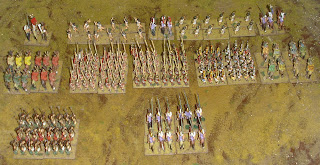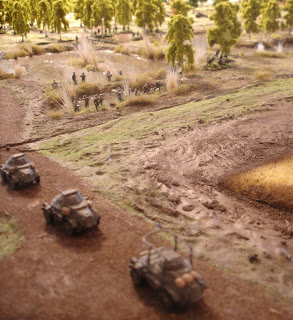The first planting (Photo taken 10:25 AM 17/12/2012):
The second planting (Photo taken 5:24 PM 17/12/2012):
Detailing commences with a dry brush of Tamiya Flat Earth
and the building of the gate out of toothpicks, which was actually quiet fun (Photo taken 9:57 AM 18/12/2012):
Fence gate finished and flocking commences (Photo taken 1:57 PM
19/12/2012):
Flocking finished. I
was going to do more work on the hedges, but decided they didn’t need it (Photo
taken 6:58 PM 19/12/2012):
Bocage finished with matt varnish. I must make some fields and roads to better
show them off, but I’m very happy with the result. Actually, they turned out much better than I
expected. The surprise “ingredient” was
the plastering which ended up looking like tangle tree roots and gives a good
earth bank effect I feel.
Perhaps the tubes (which are, after all, just cut up black
drinking straws) used to hold the trees could be a slightly smaller diameter,
but this is really lost on the table top and besides the hedges are supposed to
be a thousand years old so good fat trunks are appropriate. In the “blown up” photo the source of some of
the hedging is a lot more apparent than on the table top; perhaps the old
scouring pads need more hacking, but they do provide a bit of body to the hedge
which helps in handling (which is also a benefit of the embedded straws).
And as this was my 100th post, and close to my anniversary
of starting this blog two years ago, I feel good to present this
completed project.



















































